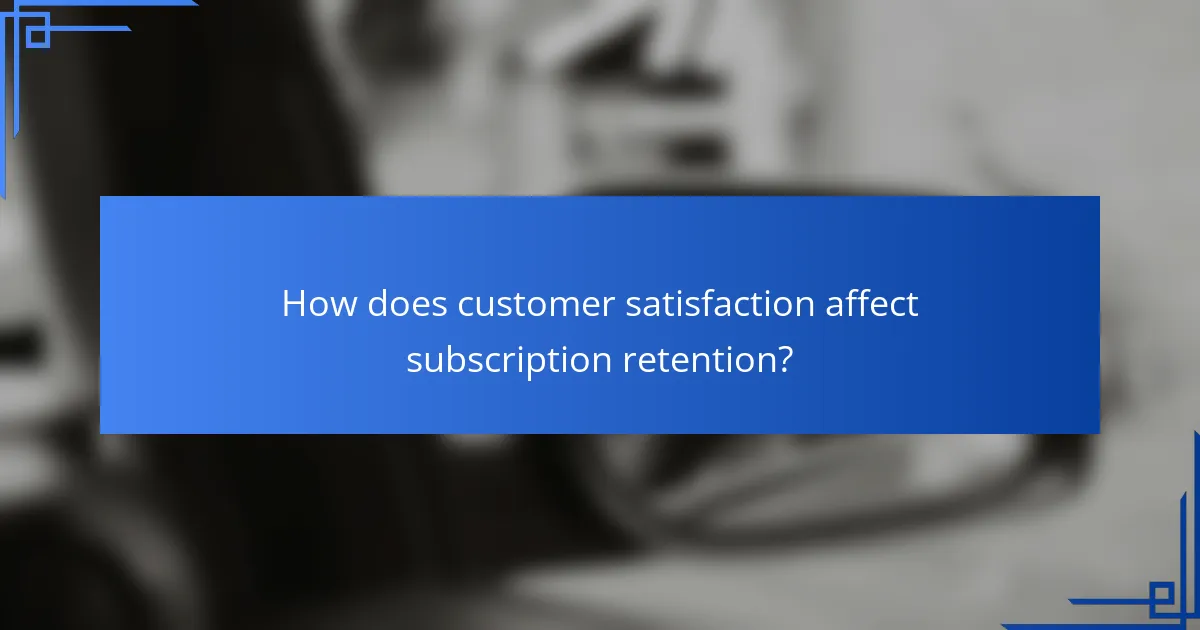Subscription memberships significantly enhance customer support by offering reliable access to assistance and resources, including 24/7 support and dedicated account managers. The responsiveness of these services, influenced by response time and support channel availability, directly affects customer satisfaction. High satisfaction levels are essential for retaining subscribers, as they foster loyalty and reduce churn rates.

How can subscription memberships improve customer support in the US?
Subscription memberships enhance customer support in the US by providing consistent, reliable access to assistance and resources. These memberships often include features like 24/7 support, dedicated account managers, and extensive knowledge bases, all aimed at improving customer satisfaction and responsiveness.
24/7 live chat support
24/7 live chat support allows customers to receive immediate assistance at any time, which is crucial for resolving issues quickly. This feature is particularly beneficial for businesses that operate across different time zones or have customers with varying schedules.
When implementing live chat, ensure that your team is well-trained and equipped to handle a range of inquiries efficiently. Consider using chatbots for initial interactions to filter common questions, allowing human agents to focus on more complex issues.
Dedicated account managers
Having dedicated account managers provides customers with a personalized point of contact for their needs. This relationship fosters trust and ensures that customers receive tailored support and solutions that align with their specific requirements.
To maximize the effectiveness of dedicated account managers, establish clear communication protocols and regular check-ins. This proactive approach helps in identifying potential issues before they escalate, enhancing overall customer satisfaction.
Comprehensive knowledge bases
Comprehensive knowledge bases serve as a self-service resource for customers, offering articles, FAQs, and tutorials that address common questions and issues. This empowers customers to find solutions independently, reducing the volume of support requests.
Regularly update the knowledge base to reflect new products, features, and common customer inquiries. A well-organized and easily navigable knowledge base can significantly enhance user experience and satisfaction.
Community forums
Community forums create a space for customers to connect, share experiences, and seek advice from peers. This collaborative environment can lead to quicker problem resolution and a sense of belonging among users.
Encourage active participation by moderating discussions and highlighting valuable contributions. Consider implementing a reward system for users who provide helpful answers, fostering a vibrant and supportive community.

What factors influence responsiveness in subscription services?
Responsiveness in subscription services is primarily influenced by response time metrics, support channel availability, and the training and resources provided to support staff. These factors collectively determine how quickly and effectively customer inquiries are addressed, impacting overall customer satisfaction.
Response time metrics
Response time metrics are crucial for assessing how quickly a subscription service addresses customer inquiries. Common benchmarks include initial response times of under one hour for email support and under five minutes for live chat. Monitoring these metrics helps identify areas for improvement and ensures timely customer engagement.
To enhance responsiveness, companies can implement automated systems that prioritize urgent requests, ensuring that critical issues are addressed promptly. Regularly reviewing response time data can help teams adjust their strategies to meet customer expectations effectively.
Support channel availability
The availability of various support channels significantly affects responsiveness. Offering multiple channels such as email, live chat, phone support, and social media allows customers to choose their preferred method of communication. This flexibility can lead to quicker resolutions and higher satisfaction rates.
Subscription services should aim to provide 24/7 support across key channels, especially for global customers. Understanding peak times for inquiries can help allocate resources effectively, ensuring that support is available when customers need it most.
Staff training and resources
Well-trained staff with access to the right resources are essential for maintaining high responsiveness in subscription services. Training programs should focus on product knowledge, customer service skills, and problem-solving techniques to empower employees to assist customers effectively.
Providing staff with comprehensive knowledge bases and easy access to relevant information can streamline the support process. Regular training updates and feedback mechanisms can further enhance staff performance, ensuring they remain equipped to handle customer inquiries efficiently.

How does customer satisfaction affect subscription retention?
Customer satisfaction plays a crucial role in subscription retention by directly influencing a subscriber’s decision to continue or cancel their membership. High satisfaction levels typically lead to increased loyalty and lower churn rates, while dissatisfaction can prompt users to seek alternatives.
Impact on churn rates
Churn rates, or the percentage of subscribers who cancel their service, are significantly affected by customer satisfaction. When users feel valued and supported, they are less likely to leave. Studies suggest that improving customer satisfaction can reduce churn by a substantial margin, often in the range of 5-15%.
To minimize churn, companies should regularly assess customer satisfaction through surveys and feedback. Quick responses to issues can also help maintain a positive relationship, reducing the likelihood of cancellations.
Customer feedback mechanisms
Implementing effective customer feedback mechanisms is essential for understanding satisfaction levels. Tools such as surveys, Net Promoter Score (NPS), and customer interviews can provide valuable insights into user experiences and expectations.
Regularly collecting and analyzing feedback allows businesses to identify pain points and areas for improvement. This proactive approach not only enhances customer satisfaction but also fosters a sense of community and engagement among subscribers.
Personalization of services
Personalization of services can significantly enhance customer satisfaction and retention. Tailoring offerings based on user preferences and behaviors creates a more relevant experience, making subscribers feel understood and valued.
Businesses should utilize data analytics to segment their audience and deliver personalized content, recommendations, and support. Simple strategies, such as customized email communications or targeted promotions, can lead to higher satisfaction and loyalty among subscribers.

What are the best practices for measuring customer support effectiveness?
Measuring customer support effectiveness involves using specific metrics that reflect customer satisfaction and responsiveness. Key practices include tracking customer feedback, response times, and overall service quality to identify areas for improvement.
Net Promoter Score (NPS)
Net Promoter Score (NPS) gauges customer loyalty by asking how likely customers are to recommend your service to others. Responses are typically rated on a scale from 0 to 10, allowing you to categorize customers as promoters, passives, or detractors.
To calculate NPS, subtract the percentage of detractors from the percentage of promoters. A score above 0 is generally considered good, while scores above 50 indicate strong customer loyalty. Regularly surveying your customers can help track changes over time.
Customer Satisfaction Score (CSAT)
Customer Satisfaction Score (CSAT) measures how satisfied customers are with a specific interaction or overall service. This is usually assessed through a short survey immediately following a support interaction, asking customers to rate their satisfaction on a scale, often from 1 to 5.
A CSAT score of 80% or higher is often seen as a benchmark for effective customer support. It’s crucial to analyze feedback to identify trends and areas needing attention, ensuring that your service meets customer expectations consistently.
First Response Time (FRT)
First Response Time (FRT) measures how quickly a customer receives an initial reply after submitting a support request. This metric is critical as it directly impacts customer satisfaction and perception of service quality.
Best practices suggest aiming for an FRT of under 1 hour for email support and within minutes for live chat or phone support. Monitoring this metric helps identify bottlenecks in your support process and can lead to improved customer experiences when addressed promptly.

How can technology enhance customer support in subscription models?
Technology can significantly improve customer support in subscription models by providing faster responses, better tracking of customer interactions, and insightful data analytics. These enhancements lead to increased customer satisfaction and loyalty, essential for subscription-based businesses.
AI chatbots for instant responses
AI chatbots offer immediate assistance to customers, addressing common inquiries and issues without delay. They can handle multiple requests simultaneously, ensuring that users receive timely support, often within seconds.
For effective implementation, businesses should ensure that chatbots are trained on frequently asked questions and can escalate complex issues to human agents when necessary. This hybrid approach maintains efficiency while providing comprehensive support.
CRM systems for tracking interactions
Customer Relationship Management (CRM) systems are vital for tracking customer interactions across various channels. They store valuable data about customer preferences, previous communications, and support history, enabling personalized service.
When selecting a CRM, consider features like integration with other tools, user-friendliness, and scalability to accommodate growth. Effective use of a CRM can lead to improved response times and a more tailored customer experience.
Data analytics for performance insights
Data analytics tools provide insights into customer support performance, helping businesses identify trends and areas for improvement. By analyzing metrics such as response times and customer satisfaction scores, companies can make informed decisions to enhance their support strategies.
Regularly reviewing analytics can reveal patterns in customer behavior, allowing businesses to proactively address issues and optimize their support processes. Establishing key performance indicators (KPIs) will help track progress and drive continuous improvement.

What are the key criteria for selecting a subscription service provider?
Key criteria for selecting a subscription service provider include customer support quality, responsiveness, and overall satisfaction. Evaluating these factors can help ensure that the service meets your needs and provides a positive user experience.
Support service offerings
Support service offerings are crucial when choosing a subscription provider. Look for options such as live chat, email support, and phone assistance, as these can significantly impact your experience. A provider that offers multiple channels allows for flexibility in how you seek help.
Consider the availability of support services. Some providers offer 24/7 support, while others may have limited hours. If you anticipate needing assistance outside of standard business hours, prioritize providers with round-the-clock support.
Additionally, assess the quality of the support. Check customer reviews and ratings to gauge responsiveness and effectiveness. A provider with a strong reputation for customer service can enhance your satisfaction and reduce frustration when issues arise.
